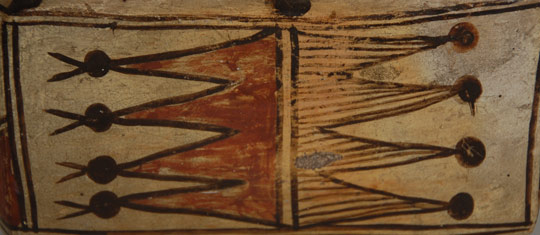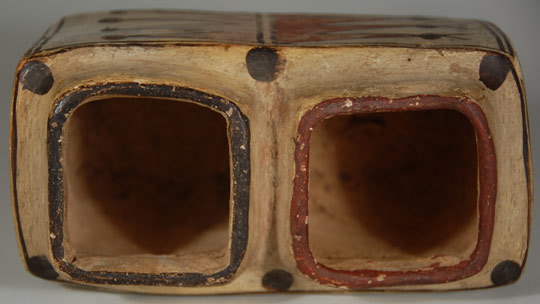Polacca Polychrome Double Chamber Pottery Box [SOLD]
+ Add to my watchlist Forward to Friend
- Category: Historic
- Origin: Hopi Pueblo, Hopituh Shi-nu-mu
- Medium: clay, pigment
- Size: 6-1/4” x 3-1/8” x 3-7/8” high
- Item # C3384B SOLD

It has remained a mystery as to the use of these rectangular pottery boxes but it is generally thought there might have been a ceremonial purpose, perhaps for use in kiva ceremonies. The jar has been identified to circa 1880 by Francis Harlow.
The two chambers of the box are divided by a wall so each chamber serves an independent purpose. On one side of the wall of the vessel, a red rim coordinates with a red wall design while a black rim coordinates with a black wall design. On the opposite side of the vessel, a red rim coordinates with a black design and a black rim coordinates with a red design. The designs on the ends of the vessel are the same. Six black dots rest on the shoulder of the box and each of the wall designs has black dots capping the triangular design.
Condition: excellent condition.
Provenance: published in the book Modern Pueblo Pottery by Francis Harlow, p 93. Harlow sold the box to pottery collector Larry Frank who eventually sold it in 2000 to Dr. Allan Cooke, co-author of the book Canvas of Clay: Seven Centuries of Hopi Ceramic Art, from whose collection it is now available.
Recommended Reading: Canvas of Clay: Seven Centuries of Hopi Ceramic Art by Edwin L. Wade and Allan R. Cooke

- Category: Historic
- Origin: Hopi Pueblo, Hopituh Shi-nu-mu
- Medium: clay, pigment
- Size: 6-1/4” x 3-1/8” x 3-7/8” high
- Item # C3384B SOLD



